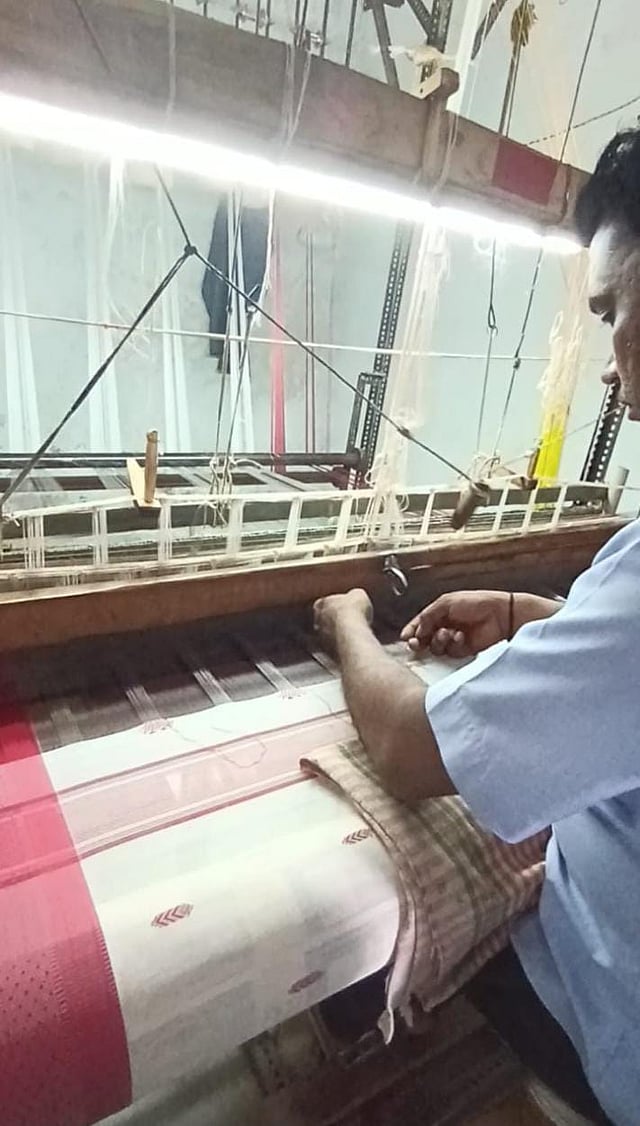1.jpg?w=480&auto=format%2Ccompress&fit=max)
1.jpg?w=480&auto=format%2Ccompress&fit=max)
Visiting Madhya Pradesh can feel like stepping through a portal into the past. The ruins of Mandu, in particular, hold power to excite and exhaust you in equal measure. For an enthusiastic trekker, these small ancient cities offer a wealth of stories to explore. An amber spool of fabric with a vivid red block print motif was looped through my neck as I wound my way up to the Rani Roopmati Pavilion.
Bagh Print
&ldquoThis scarf took us a month to make,&rdquo says Guru Dutt Kaatey, a master of the Bagh printing technique. The wooden hand-block print is believed to be some 1,000 years old, originating around the Indus Valley through the Khatri community, who later settled in Madhya Pradesh&rsquos Dhar district. &ldquoWe take the prepared fabric, with the final printing and go to the river to wash them. Flowing water is a must. It can&rsquot be done in still water,&rdquo explains Kaatey. His family has been doing this for as long as he can remember.
It is a painstaking process, as are most handmade textile weaving procedures. &ldquoWe usually buy grey-coloured fabrics from the market and rinse them with goat dung and castor oil,&rdquo says Kaatey. The two are natural softeners. They use natural red and black colours for printing&ndash alum for deep reds and a mix of jaggery with iron rust for the black colour. After the printing is finished, they leave the fabric for ten to fifteen days to dry. The freshly printed fabrics are washed in the flowing river to enhance their colours.The richer the mineral content in the water, the better the outcome.
The faded frescoes adorning the Bagh caves, some 97 km from Dhar, comprise many of the signature floral and geometric motifs of Bagh print. Only five remain out of the original nine sandstone rock structures on the banks of the Baghini river. &ldquoEverything here has roots in ancient times- it&rsquos the past preserved,&rdquo explains our guide, Sunil Kewat,as he led a gaggle of hungry historians and curious tourists, myself included, through the Ahilya Bai Holkar fort.
This ancient hand-block printing is found in mostly cotton fabric, and other materials like silk, chiffon, jute, Maheshwari and Chanderi silk.

Maheshwari Weave
Some 40 km from Mandu and 95 km from Indore, lies a small town still fairly unspoiled by tourists and modern technology. Maheshwar was home to Maratha warrior queen Ahilya Bai Holkar who established it as the seat of an empire. Being a patron of the arts and crafts, she opened her doors to poets, scholars and artists, going as far as setting up a thriving textile industry in the city. Thus began the handloom weaving tradition of Maheshwar, which went on to lend its name to the beautiful, lightweight handlooms.
We were led through the narrow, slightly cobbled path inside the beloved queen&rsquos fort, passing by the gates of Maheshwar&rsquos famed Rehwa Society&ndash home to some of the finest weavers of the Maheshwari sarees. Starting in the late 1700s, the art of weaving has flourished in Maheshwar, one of the remotest temple towns in the country.
The slow, laborious weave of Maheshwar textile results in gorgeous, lightweight sarees much coveted, says Chetan Mawade, who owns a weaving factory here. Traditionally made in bright colours&ndash like jade greens, canary yellows, crimsons and peacock blues, Maheshwari sarees were originally woven only in pure cotton threads, with pallus (drapes) on both ends, which could be worn either way in case one end frayed. Now, weavers have evolved the process owing to changing demands. &ldquoThe cotton yarns are alternately weaved with silk ones. You see the red thread mixing with the white,&rdquo he points to a blur of movements as the weaver kept pushing the pedal, his hands twisting and turning the yarn in impossible loops. &ldquoAfter this, the zari work will be done, but some of our buyers, like Fabindia, prefer the sarees without the zari work,&rdquo Mawade explained, pointing at exceptionally fine linework and zari borders.

It takes four to five days for one saree to be complete. The feather-light weight is due to the proportionate mixing of cotton with silk which also gives a nice shine to the finished products.
As we walked away, the image of a lone woman weaver in a cluster of men stood out. Beneath her fingers, a striking saree fit for a queen was materialising as she sat in a corner in her simple cotton drape, toiling away at the heavy wooden loom.
